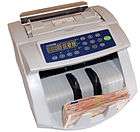Banknote counter
A banknote counter or bill counter is a device designed primarily to accurately count a quantity of banknotes. Additionally, a banknote counter may sort banknotes into batches and check for damaged or counterfeit notes.

History
The first automatic bill counting machines (or money counting machines) were introduced in the 1920s in the United States and were produced by the Federal Bill Counter Company of Washington, D.C. These machines were designed to increase efficiency in tellers in the Federal Reserve Bank and reduce human error. The machine would stop once a set “batch” of notes was reached allowing a teller to insert a wooden block to keep batches separate.[1]
Modern counting machines use a technology developed by Tokyo Calculating Machine Works of Shinagawa, Tokyo and introduced in 1962. It quickly dominated the market for increased speed and accuracy.[2]
In 1981 computerized friction note counters were introduced in the form of the REI High-Speed machine, which sped up note counting to 72,000 notes per hour and eliminated the need manual sorting and counting completely. This innovative Sorter machine could also sort notes according to their value and remove counterfeit or heavily damaged notes.[3] Many of these features are present in today’s note counting machines, some of which can detect a note's security features (e.g. magnetic ink, ultraviolet ink, magnetic strip, note density etc.) to identify counterfeit and damaged notes.[4]
Other extra features that facilitate everyday contact with cash may also be present.
Electronic counters for bills/ money and coins
Electronic counting systems, with no moving parts, exist that count both notes and coins on the same machine and sum the value of all denominations counted. They are normally used to count individual deposits or the content of cash drawers and do not sort or check for counterfeit or damaged notes. The machine uses a LC display with a back light so that the total amount of the notes is shown brightly and is easy to see.[5]
These cash counters do not examine each note or coin separately but work by using finely calibrated loadcells to assess a number of notes or coins at a time, and using a constantly updated, stored average weight to compute the number of pieces it has been presented with. These machines often use complex algorithms to take into consideration the variation in the condition of the money arising from wear, humidity and production variances.
Electronic cash counters tend to be small in size, silent, battery operated, very fast and accurate. They are often used on the desktops of bank tellers to check customer deposits or withdrawals or by retailers to count money from cash registers. Although their capability varies by model, typically they can count both notes and coins and check standard bank bundles or bags/rolls of coin to ensure that they are correct. This technology was invented in 1979 by Edgar Biss who went on to form the global company Tellermate.
Counterfeit detection
With more & more counterfeit bills bleeding into circulation, it is faster and more accurate to rely on money counters that are able to utilize the security features in currency. Using money counters save a person vast amount of time, eliminate human error while counting, and don’t let counterfeit money to pass.
Most of bill counters have counterfeit detection measures including ultraviolet (UV) and magnetic (MG) detection. This means the counter will scan the ultraviolet properties of the bills and the magnetic ink at the same time it is counting the currency. Most counters will stop and alert the user when a counterfeit banknote is detected.[6] While counterfeit transactions can cost small businesses millions of dollars annually, counterfeit detection feature helps to reduce losses due to suspected counterfeits.
Ultraviolet Detection (UV)
Ultraviolet Detection works by shining a UV light as a bill passes through the machine. When the bill goes under ultraviolet light, the security thread becomes visible and glows pink. This causes the security thread in the bill to glow pink. If the security thread glows any other color it will be flagged as a counterfeit a will be rejected.
Magnetic Detection (MG)
Counterfeit money detectors use magnetic detection to identify the magnetic ink and metal threads placed on strategic areas of bank notes. Magnetic detection works by detecting the magnetic threads & magnetic ink in a bill as it passes through the machine.
Mixed Bill Counters or Reader
Unlike a money counter, a Mixed Bill Counter & Reader is able to read a mix stack of bills as it's fed through and automatically determine what denomination it is ($1, $2, $5, $10, $20, $50 and $100 bills), while providing a total added value as well as a breakdown of all bills counted by their denomination.
Footnotes
- Wells, Donald (2004) The Federal Reserve System: A History (Chapter 6) New York: Digital Vision
- Tavlas, George S. and Yuzuru Ozeki (1992) The Internationalization of Currencies: An Appraisal of the Japanese Yen (Occasional Paper (Intl Monetary Fund)) Washington: International Monetary Fund
- "Archived copy". Archived from the original on 2007-03-14. Retrieved 2007-07-13.CS1 maint: archived copy as title (link)
- http://www.google.com/patents?id=ROoJAAAAEBAJ
- "Banknote Counter Aflak Electronics". Archived from the original on 14 December 2014. Retrieved 5 December 2014.
- "Bill Counter Guide & Counterfeit Detection". Retrieved 2009-09-10.